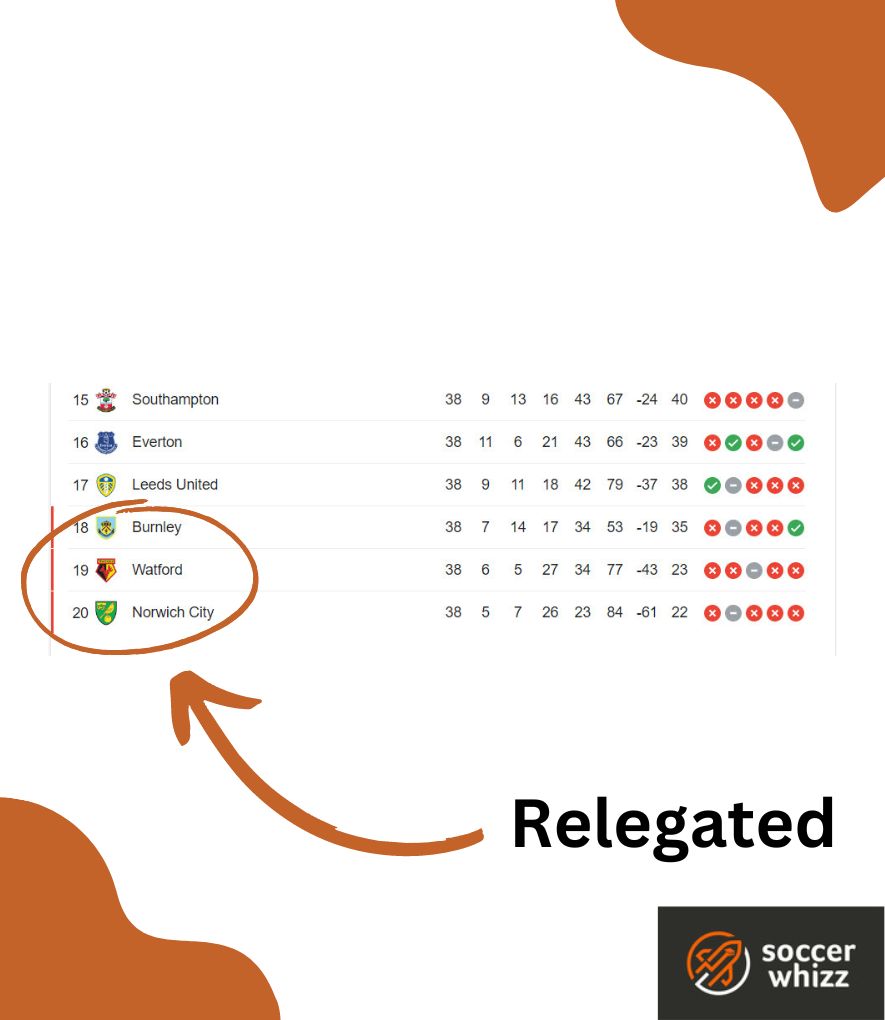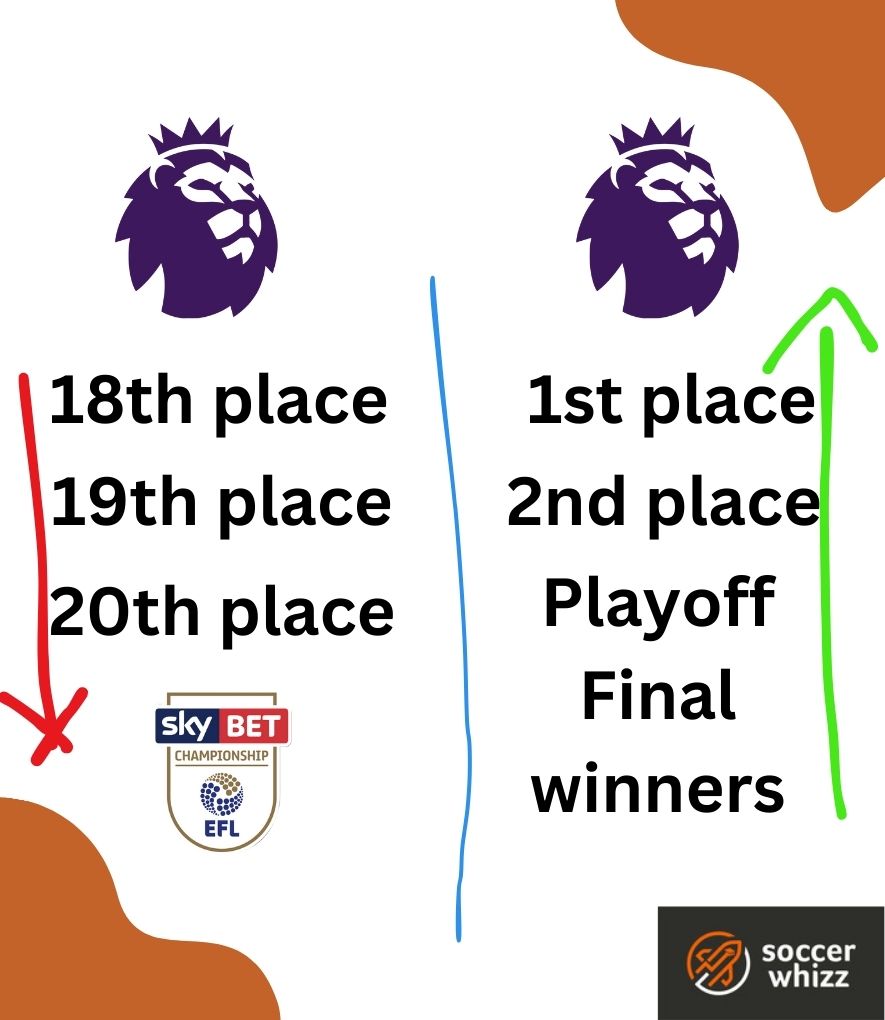For every tale of championship triumph and heroic victories, there are narratives of heartbreak, disappointment, and the consequential fall from grace.
Relegation serves as a mechanism to maintain competitive balance and ensure the sustainability of soccer leagues, while simultaneously injecting a potent dose of excitement and tension into the sport.
This article delves into the intricacies of relegation by examining its significance, mechanics, as well as looking at the broader impact it has on the soccer landscape.
We’ll also explore how relegation functions as a driving force behind the pursuit of excellence and survival, dissecting its historical origins and shedding light on the emotional roller coaster experienced by both players and fans alike.
What does it mean to get relegated in soccer?
The concept is quite simple to explain…
Relegation refers to the unfortunate descent of a team from its current league to a lower-tiered competition. This demotion occurs when a team concludes a season at the bottom of the league table, signalling their inability to maintain the required level of performance.

As a consequence, the relegated team initiates the subsequent season in a lower division, striving to regain their former status.
Relegation in soccer operates as a well-established mechanism that orchestrates the transfer of the lowest-ranked teams from one division to a lower division for the forthcoming season.
This system instils a sense of urgency and desperation within teams, compelling them to exert maximum effort in order to avoid the dreaded fate of relegation. The mere possibility of being relegated can serve as a potent motivator, spurring teams to fiercely compete until the very last game of the season.
More so, the significance of relegation lies in its ability to evoke a heightened sense of competition and determination among teams. It transforms the soccer landscape into a battleground where every point matters and every match becomes a crucial opportunity for survival.
The fear of relegation hangs ominously over teams, pushing them to push their limits, showcase their abilities, and strategize tirelessly to secure their place in the upper tiers of the league.
What happens when a soccer team gets relegated?
The process of relegation operates by identifying and relocating the least successful teams in a league as the season draws to a close, leading them to compete in a lower-ranked division in the subsequent season.

Within English soccer, a comprehensive structure known as the English Football League system (often referred to as the football pyramid) governs a network of interconnected competitions for men’s associated football leagues.
This intricate framework encompasses a range of divisions within England and includes representation from five teams in Wales, as well as one each from Guernsey, Jersey, and the Isle of Man.
The English Football League system operates on a hierarchical basis, employing the promotion and relegation system as its fundamental mechanism.
At the summit of this hierarchy lies the prestigious English Premier League, widely regarded as the pinnacle of football in the country.
The competition is responsible for organizing and overseeing divisions two through four, while divisions five through ten are administered by the Football Association (FA), which manages the National League System.
Additionally, the remaining feeder competitions operate on an ad hoc basis under the supervision of county Football Associations (FAs).
Although the composition of clubs within each league may fluctuate due to factors such as club introductions, departures, mergers, or dissolutions, there exists an upper limit on the total number of clubs.
With an estimated average of 15 clubs per division, the English men’s Football League system encompasses a staggering total of nearly 5,300 clubs, contributing to a vast network of approximately 7,000 teams across the various leagues.
Related read: how many soccer teams there are in the world
When was relegation introduced into competitive soccer leagues?
Back in the year 1892, a ground breaking concept emerged in the English Football system – the promotion-relegation system.
This innovative framework revolutionized the way teams moved between divisions, replacing the outdated method of relying on group votes to determine which teams would ascend or descend.
Prior to the introduction of the promotion-relegation system, the fate of teams in terms of divisional movements relied on collective decisions made by groups involved in the footballing landscape.
This method often involved arduous voting processes to determine which teams would be promoted or relegated.
However, with the advent of the promotion-relegation system, this approach was replaced with a more structured and merit-based mechanism.
The new system allowed teams to earn their place in higher divisions through exceptional performance on the pitch, eliminating the subjective nature of the voting process.
How does relegation work in the Premier League?
The illustrious Premier League, where 20 teams annually vie for the coveted title of the nation’s finest soccer team.
However, as the season progresses, certain teams inevitably find themselves unable to keep pace with the fierce competition.
These struggling teams endure a series of setbacks, accumulating more defeats, conceding a greater number of goals, and ultimately languishing at the bottom of the league standings when the curtain falls on the final game of the season.
It is at this point that the mechanisms of Premier League relegation come into play, as the three teams occupying the bottom positions are designated for relocation to the English Football League Championship, the second-highest league in England.

Subsequently, these three relegated teams embark on a new journey, competing within the Championship throughout the entirety of the following season.
Are there any plans to change the relegation system within soccer?
Without the implementation of a relegation system, teams positioned below the top half of the table would lack sufficient motivation to maintain a high level of exciting and competitive football.
Instead, these teams would likely transition into becoming development-focused entities or perennial strugglers akin to the Kansas City Royals in baseball, perpetually residing at the bottom of the league.
Opposing the notion that eliminating the relegation system would enhance competition at the top of the table and potentially dismantle the established “top six” clubs, is a fallacious argument.
The dominance of these prominent teams, often referred to as the “Big Four”, or now expanded to the “Top Six”, can primarily be attributed to their consistent success and financial strength.
Historical achievements of these clubs are intricately tied to a legacy of managerial excellence demonstrated by esteemed figures, such as:
- Sir Matt Busby;
- Bob Paisley;
- Sir Alex Ferguson; and
- Arsene Wenger
As a result, there are currently no plans to abolish the promotion and relegation system.
Concluding thoughts
The relegation system in soccer fuels the pursuit of excellence and injects a sense of urgency into every match.
It compels teams to push their limits, showcase their abilities, and fight tooth and nail to secure their place in higher divisions.
The possibility of relegation can inspire both players and fans, igniting an unwavering competitive spirit that fuels thrilling performances and unforgettable moments on the pitch.
For more information on soccer’s core concepts, have a read through the following content pieces:
- what a treble in soccer represents;
- what a derby in soccer is all about;
- what a golden goal in soccer means; and
- how many fixtures make up a complete Premier League season
If you enjoy the content that I create and would like to buy me a coffee, then I’d really appreciate it!
Any money that I earn through this donation will be re-invested into more content for this website.
Additionally, by sending in a donation you’ll also receive a copy of my recently released 190+ page eBook on Soccer Ball Care, as well as be subscribed to our mailing list where you’ll be regularly informed on the latest developments concerning the Soccer Whizz blog.
- Future Icons: Europe’s Emerging Midfield Maestros Set for Glory - December 4, 2023
- Kickstarting a Revolution: How Soccer Transformed the United States Over the Last Four Years - October 7, 2023
- 4-1-4-1 Soccer Formation [Analysis] - September 23, 2023

